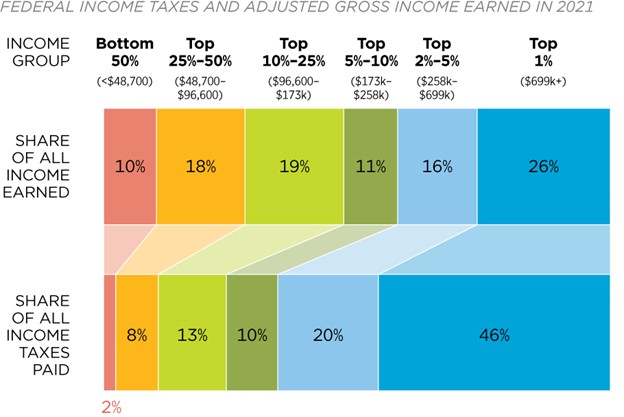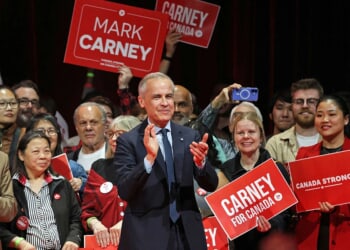Op-ed views and opinions expressed are solely those of the author.
President Trump has proposed cutting taxes for all Americans. He wants the 2017 tax cuts made permanent, which resulted in virtually all Americans having their tax bill cut by 10%. Further, he wants to eliminate taxes on tips, Social Security, and overtime pay. Since he also wants to reduce the deficit and ultimately balance the budget, will a tax increase on the highest income earners be necessary?
Some members of Congress believe that the only way to increase tax revenue enough to cover the cost of those tax cuts is to raise the tax rate on the highest income earners. That will result in an outcome exactly opposite of the intention.
According to the Heritage Foundation:

The chart above shows that almost half of the income tax revenue comes from the top 1% of income earners. About two-thirds of tax revenue comes from the top 5% of income earners. About half of all income earners pay almost no federal income tax.
It is obvious that the highest income earners are already over-taxed.
Some members of Congress want to increase the tax rate for the top 1% of income earners. Not only is that blatantly unfair, but it may also result in less tax revenue, and it will tend to slow economic growth.
The Trump administration is pushing hard to bring manufacturing back to America, especially for products vital to national security, like steel, aluminum, copper, and medical products. The reason these products are imported is simply because it is less expensive.
Trump’s plan is to put a 25% tariff on these products, meaning the imported goods will be more expensive than the domestically produced goods. That means manufacturing will return to the US, and we will see a revitalization of these key industries.
The problem is that American consumers will have to pay more. To offset that, US firms will see much lower energy costs and will manufacture using capital-intensive rather than labor-intensive techniques. The foreign goods are much cheaper because foreign labor is often paid $1 per hour. US manufacturing workers average $30 to $40.
US companies will replace relatively high-cost and scarce labor with robots, automation, and AI. That will result in lower manufacturing costs, so that the final price that consumers pay for domestically produced goods will not be much higher than the foreign goods.
There are already some examples of how replacing labor with capital results in lower costs. In the fast-food industry, unskilled workers have seen a large increase in wages due to the raising of the minimum wage and the general labor shortage.
To offset that, these restaurants have replaced many workers with touch screens that allow a customer to order and pay for everything they want. A typical fast-food restaurant may have had 8 to 10 workers before the wage increases; now they have 3 or 4 workers with automation.
For this to continue, the US economy must produce large amounts of new capital. New capital comes from two sources.
After corporations earn income, they pay their taxes, give their shareholders the agreed-upon dividend, and retain the rest. The retained earnings create new capital for the corporation.
Fortunately, the tax cut passed in 2017 lowered the corporate tax rate from about 35% to 21%, which created more retained earnings and more new capital.
But most of the new capital comes from individuals. After individuals pay their taxes and spend to support their lifestyle, the balance is saved or invested, creating new capital. The highest income earners create most of the new capital. Raising their taxes, and assuming they will maintain their lavish lifestyle will result in less savings and investment, leading to less capital formation.
In about 150 years after the birth of our nation, the US had the largest, most prosperous economy with the highest standard of living. That was somewhat due to the low rates of taxation.
In 1997, President Clinton lowered the capital gains tax rate from 28% to 20%. That led to increased tax revenue, four years of a surplus in the federal government budget, and four years of annual economic growth exceeding 4%.
Raising taxes on the highest income earners is not only blatantly unfair, but it is counterproductive. Let’s not do that.
DONATE TO BIZPAC REVIEW
Please help us! If you are fed up with letting radical big tech execs, phony fact-checkers, tyrannical liberals and a lying mainstream media have unprecedented power over your news please consider making a donation to BPR to help us fight them. Now is the time. Truth has never been more critical!
Success! Thank you for donating. Please share BPR content to help combat the lies.
We have no tolerance for comments containing violence, racism, profanity, vulgarity, doxing, or discourteous behavior. If a comment is spam, instead of replying to it please click the ∨ icon below and to the right of that comment. Thank you for partnering with us to maintain fruitful conversation.



![Pentagon Begins Booting Trans Troops After Supreme Court Greenlights Ban [WATCH]](https://www.right2024.com/wp-content/uploads/2025/05/Pentagon-Begins-Booting-Trans-Troops-After-Supreme-Court-Greenlights-Ban-350x250.jpg)


![Trump Posts Hilarious Pope Meme, Leftists Immediately Melt Down [WATCH]](https://www.right2024.com/wp-content/uploads/2025/05/Trump-Posts-Hilarious-Pope-Meme-Leftists-Immediately-Melt-Down-WATCH-350x250.jpg)










